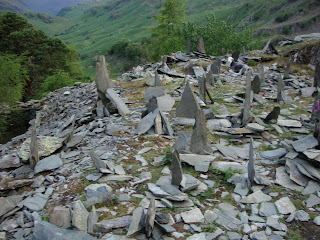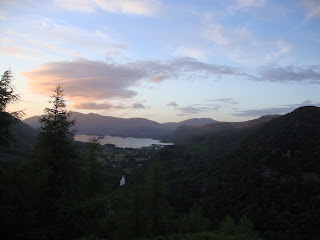I haven't blogged in a few days, mostly because I haven't been doing much as far as research goes. I'm in Cumbria, the Lake Country, with its mountains and moors and glacial lakes thousands of feet above the valleys. During the morning and daytime, when my host is out teaching mathematics, I am working on the computer, brushing up on Celtic and Anglo-Saxon history to better inform my decisions concerning the rather questionable accuracy of some of the Neo-Pagan movements. I have also been selecting films from my host's formidable cheesy horror movie collection to see where some of the misconceptions about paganism in our modern society may have originated. Primary in the movies that formed at least the British perception of paganism is the excellent (but of course extremely inaccurate) movie, The Wicker Man, a thriller about an isolated pagan isle who's crops failed and perform a human sacrifice.
Although isolated incidents similar to the Wicker man happened over a thousand years ago, the groups that you may hear about nowadays that perform these strange and criminal acts are in no way connected to the Neo-Pagan movement. Almost all Neo-Pagans really despise The Wicker Man because of the horrible picture it paints of lascivious and violent people paying homage to the 'old gods.' However, this is not the practice of pagans, either in the past or today.
After my host gets home from work, we have been going out and hiking in the beautiful hills in the Lake Country. The first day we went out to some of the Northern Lakes, taking a small hike around the hills, visiting a slate mine, scrambling on rock faces, and generally taking in the magnificent scenery. I have never seen a more beautiful landscape. We climbed up a place called Castle Ridge, and at the top, there was an abandoned slate mine. The mine has long since been closed up, but there is a mountainous pile of surplus slate that the quarriers had formed a labyrinthine path into, winding all the way to the top. There, in a flat clearing there has been a tradition for who knows how long to erect a small bit of slate in memorandum of the climb. James calls it the slate graveyard, and I must admit that the field of jutting black rocks does look a bit cemetery-like. You can see small sections of it below, along with other pictures from the first hike.
The second day we hiked, rather than took a walk. The hills were farther to the east, and much higher. The weather was overcast, windy, and temperamental. Atmospheric, misty, blue, cold, sharp, the weather, rather than bringing me down or discouraging James and I, simply egged us on, like Thor himself was beckoning us to do war with him. "Onward!" we would shout after a rest on the wet stones, nearly beaten by the sheer difficulty of the upward climb. When we got to the Red Tarn, a glacial lake near the summit of one of the highest peaks (Helvellyn), we turned and walked down the ridge back to Glenridding, where we had parked the car. Far from being the hellishly cold, wet, and tiring experience that it sounds like, I don't think I've felt more empowered in my life! Take your thunder back, Thor! Again, the pictures below will give you some indication of the beautiful landscape.
We're thinking now about journeying into Scotland, to see the hiking up there. From there, I think I'd like to go to Newcastle for a day, then down to London for a day. And from there, I will be going West into Cornwall, where there are some very ancient ways of life, and tons of ancient sites. That is actually much closer to my area of study, which focuses on folklore and 'superstitions' in the British community. I will then go to Bristol where I will meet Ronald Hutton, the expert on British paganism and someone I am considering studying with. Anyway, that's the plan for now, of course subject to change. Hope you enjoy the pictures!






































These pictures are beautiful! Wish I were hiking with you! aunt jeannine
ReplyDelete